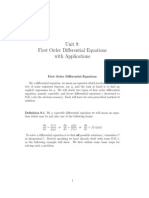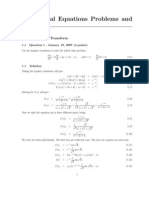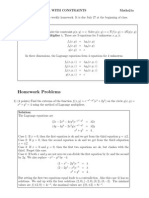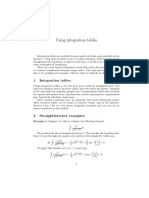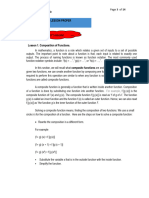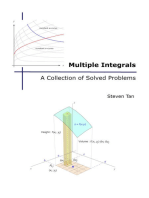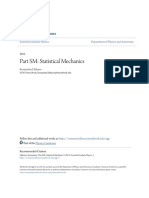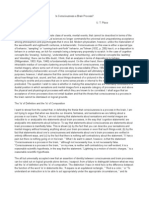Tanydy: Arctan X DX
Tanydy: Arctan X DX
Uploaded by
artecmkCopyright:
Available Formats
Tanydy: Arctan X DX
Tanydy: Arctan X DX
Uploaded by
artecmkOriginal Title
Copyright
Available Formats
Share this document
Did you find this document useful?
Is this content inappropriate?
Copyright:
Available Formats
Tanydy: Arctan X DX
Tanydy: Arctan X DX
Uploaded by
artecmkCopyright:
Available Formats
MATH 31A (Butler)
Practice for Final (B)
Try to answer the following questions without the use of book, notes or calculator;
but you can use the equation sheet posted on the course website. Time yourself and
try to nish the questions in less than three hours.
1. Show that
_
/4
0
tan x dx +
_
1
0
arctan x dx =
4
. (Hint: interpret each integral as
an area and show how the areas piece together.)
First we note that we can change the dummy variables inside the integral.
In particular, we are trying to nd
_
/4
0
tan y dy +
_
1
0
arctan x dx.
But since x = tan y if and only if y = arctan x (for x and y in this range),
then these two integrals both involve the same curve. In particular, these
integrals correspond to the respective areas shown below.
1
4
y=arctan x
or x=tan y
1
0
arctanxdx
/4
0
tany dy
Since the two areas piece together to form a rectangle with dimensions 1 and
4
then the combined area is the area of the rectangle which is
4
.
2. A particle moves along the curve implicitly dened by xy
4
yx
4
= x y
2
. When
the particle passes through the point (1, 1) its x coordinate is changing 1/4 units per
second. How fast is the y coordinate changing?
We have x = 1, y = 1 and
dx
dt
=
1
4
and we are looking for
dy
dt
. This is
a related rates problem and so we take the derivative of both sides of the
implicitly dened function with respect to t. So we have
dx
dt
y
4
+ x4y
3
dy
dt
dy
dt
x
4
y4x
3
dx
dt
=
dx
dt
2y
dy
dt
.
Substituting what we know we have
1
4
1
4
+ 141
3
dy
dt
dy
dt
1
4
141
3
1
4
=
1
4
21
dy
dt
,
which rearranges to
(4 1 + 2)
dy
dt
=
1
4
1
4
+ 1 or 5
dy
dt
= 1 or
dy
dt
=
1
5
units
sec
.
3. The night before the nal you have decided to do one last study session. But
before you begin you decide that you want to make the best use of your time. You
know that there is a diminishing return to the amount of time you study (i.e., you get
more out of your rst hour of study than you will your second; and more out of your
second hour than you will your third). At the same time you know that the longer
you study the less sleep you will have and the harder it will be to concentrate on the
test (which will make problems about optimizing your study session even harder!).
After thinking about it for a few minutes you decide if H is the number of hours that
you study that night then you anticipate your score on the nal will be
115
50
H + 1
8H,
more or less. How many hours should you study to maximize your score, and what
should your anticipated score on the nal be?
This is clearly an optimization problem since we are trying to maximize our
score. So in this case we will take the derivative and set it equal to 0 (note
that clearly we must have H 0 since we cannot go back and study less in
the past). So taking the derivative of our anticipated score we have
d
dH
_
115
50
H + 1
8H
_
=
50
(H + 1)
2
8.
For H 0 this is never undened so our only critical point will be when the
derivative is 0, which happens when
50
(H + 1)
2
= 8 or (H + 1)
2
=
50
8
=
25
4
or H + 1 =
5
2
so H =
3
2
hrs.
We only found one critical point and so that must be the right answer (unless
somehow studying this length of time is the way to minimize our score!) But
to double check by taking the second derivative we get 100/(H +1)
3
which
is clearly negative at H = 3/2 so that by the second derivative test this is a
maximum.
So we should study for H = 3/2 hours, or an hour and a half, and our
anticipated score on the nal will be
115
50
(3/2) + 1
8
3
2
= 115
50
5/2
12 = 115 20 12 = 83.
Now if we can only get the graders to give us that score we would be happy!
4. Use the following information to get an estimate for g(f(2.1)).
x 0 1 2 3
f(x) 1 3 0 2
f
(x) 1 2 3 0
g(x) 3 0 1 2
g
(x) 1 3 2 2
It seems reasonable to thing that g(f(2.1)) should be close to g(f(2)). So let
us nd the tangent line to h(x) = g(f(x)) at x = 2 and evaluate it at x = 2.1
to get our approximation. To do this we note that h
(x) = g
(f(x))f
(x) and
so
h(2) = g(f(2)) = g(0) = 3, and
h
(2) = g
(f(2))f
(2) = g
(0)f
(2) = 13 = 3.
So we have that the tangent line to h(x) at x = 2 is
y = 3 + 3(x 2) = 3x 3.
Therefore plugging in x = 2.1 we have
g(f(2.1)) = h(2.1) 32.1 3 = 3.3.
5. (a) Find
_
_
sec + tan
_
2
d.
We rst work on rewriting the integral. Expanding we have
_
_
sec + tan
_
2
d =
_
_
sec
2
+ 2 sec tan + tan
2
_
d.
The sec
2
term and the 2 sec tan term are both easy to integrate, but
we dont have a way to integrate the tan
2
term. But that is no problem
because we can substitute sec
2
1 for tan
2
. And so we have
_
_
sec
2
+ 2 sec tan + tan
2
_
d
=
_
_
sec
2
+ 2 sec tan + (sec
2
1)
_
d
=
_
_
2 sec
2
+ 2 sec tan 1
_
d = 2 tan + 2 sec + C.
(b) Find
_
x
x
2
+ 1 + x
dx.
To start let us multiply top and bottom by the conjugate of the bottom (this
will help to simplify the denominator). So we have
_
x
x
2
+ 1 + x
dx =
_
x
x
2
+ 1 + x
x
2
+ 1 x
x
2
+ 1 x
dx
=
_
x
x
2
+ 1 x
2
(x
2
+ 1) x
2
dx =
_
_
x
x
2
+ 1 x
2
_
dx
=
_
x
x
2
+ 1 dx
_
x
2
dx =
_
x
x
2
+ 1
. .
u = x
2
+ 1
du = 2dx
dx
1
3
x
3
+ C
=
_
u
1/2
1
2
du
1
3
x
3
+ C =
1
2
2
3
u
3/2
1
3
x
3
+ C
=
1
3
(x
2
+ 1)
3/2
1
3
x
3
+ C.
We also needed to use substitution in the middle. Note that in this case we
broke the integral up over addition before we did the substitution. This was
because the same substitution would have gotten us into more trouble had
we tried to apply it to the integral of x
2
, besides which the integral of x
2
is
easy enough to do by itself!
6. Suppose that y
(t) = 2sin(t) and that y(0) = 2 and y(2) = 5. What is y
(1)?
Let us try and construct y
(t). We know that
y
(t) =
_
y
(t) dt + C =
_
_
2 sin(t)
_
dt + C = 2t +
1
cos(t) + C.
Now if we know the constant C we would be done, but we dont have any
information about y
to use to determine C, what we do have is information
about y so let us now turn to nding y. So we similarly have
y(t) =
_
y
(t) dt + D =
_
_
2t +
1
cos(t) + C
_
dt + D
= t
2
+
1
2
sin(t) + Ct + D.
(Note that D is a constant but it is arbitrary and can be dierent from C,
hence we used a dierent letter to denote this dierent constant.) Now we
do have information about y, in particular we can use the two known values
of y to solve for the two constants C and D. So we have
2 = y(0) = D,
5 = y(2) = 4 + 2C + D.
From these we see that D = 2 and then 2C = 3 or C =
3
2
. Therefore we
have
y
(1) = 2 +
1
cos + C = 2
1
+
3
2
=
7
2
1
.
(Note: this problem is similar in spirit to problems in dierential equations
where we know what the function is on the boundary and we try to gure
out what the function is doing on the interior given that it satises some
relationship with its derivatives. This turns out to be important for physics
and many other problems.)
7. Let H(x) =
_
x+2
x
2
h(t) dt where h(t) is the function dened piecewise by
h(t) =
_
_
4 2t if t 2,
_
4 (t 4)
2
if 2 t 5,
3 if t 5.
A graph of this function is shown on the
right. Find the following values.
1 2 3 4 5 6 7 8 9
1
2
3
4
5
(a) H(2) =
Using the area of a triangle, the area of one fourth of a circle, and basic
properties of the integral we have
H(2) =
_
0
4
h(t) dt =
_
4
0
h(t) dt =
_
1
2
24 +
1
4
2
2
_
= 4 .
(b) H(0) =
Using the area formula for a triangle, we have
H(0) =
_
2
0
h(t) dt =
1
2
24 = 4.
(c) H
(1) =
By the FTC we have that H
(x) = h(x + 2)1 h(x
2
)2x, so we have
H
(1) = h(3) 2h(1) =
3 22 =
3 4.
(d) H(2) =
Using basic properties of integration we have
H(2) =
_
4
4
h(t) dt = 0.
(e) H(3) =
Using the area formula for a rectangle, we have
H(3) =
_
5
9
h(t) dt =
_
9
5
h(t) dt = 4
3.
8. What is the average area of circles where the radii of the circles can range from 1
to 4?
The area of a circle with radius r is r
2
. Therefore to nd the average area
of circles with radii between 1 and 4 is the same as nding the average of r
2
with 1 r 4 which is
Average =
1
4 1
_
4
1
r
2
dr =
3
1
3
x
3
r=4
r=1
=
9
_
4
3
1
3
_
=
9
(64 1) = 7.
9. Let h(x) be a function such that
_
2
0
h(x) dx = 1,
_
3
0
h(x) dx = 2,
_
4
0
h(x) dx = 6,
_
5
1
h(x) dx = 5, and
_
5
2
h(x) dx = 7.
Find
_
3
1
h(x) dx.
Our basic approach is to combine these integrals for which we have a value
in various ways to get information about the integral we are interested in.
One approach is as follows:
_
5
0
h(x) dx =
_
2
0
h(x) dx +
_
5
2
h(x) dx = 1 + 7 = 8.
Using this we have
_
1
0
h(x) dx =
_
5
0
h(x) dx
_
5
1
h(x) dx = 8 5 = 3,
So nally we have
_
3
1
h(x) dx =
_
3
0
h(x) dx
_
1
0
h(x) dx = 2 3 = 1.
(Note that we did not need to use all of the information given to us.)
10. A torus (or as Homer Simpson would say mmmmm, donut) can be formed by
spinning a circle around the x-axis. Find the volume of the torus found by spinning
the circle of radius 1 centered at (0, 2) around the x-axis.
(Hint: the curve describing the top of the circle is y = 2 +
1 x
2
while the curve
describing the bottom of the circle is y = 2
1 x
2
.)
This is nding a solid of revolution, for which we have nice formulas for. In
particular we have
Volume =
_
1
1
_
_
2 +
1 x
2
_
2
_
2
1 x
2
_
2
_
dx
=
_
1
1
_
_
4+4
1x
2
+(1x
2
)
_
_
44
1x
2
+(1x
2
)
_
_
dx
= 8
_
1
1
1 x
2
dx
= 8
2
= 4
2
.
(Or as Homer would say four square pies, mmmmm.) For the last step
we used that
_
1
1
1 x
2
dx is the area of half of a circle of radius 1, so has
value /2.
You might also like
- Construction of Embankment and Sub-GradeDocument63 pagesConstruction of Embankment and Sub-Gradeਸੁਖਬੀਰ ਸਿੰਘ ਮਾਂਗਟ100% (1)
- 1-3 Practice - ADocument3 pages1-3 Practice - AStanleyNo ratings yet
- ABRAMS (1924) - Design of Concrete MixturesDocument24 pagesABRAMS (1924) - Design of Concrete MixturesKimberley Holland100% (1)
- 175 Fall2009 Final SolDocument6 pages175 Fall2009 Final Solnurullah_bulutNo ratings yet
- Differentiation Under The Integral SignDocument18 pagesDifferentiation Under The Integral SignStephen RickmanNo ratings yet
- Integral Calculus Module 2Document3 pagesIntegral Calculus Module 2AldzNo ratings yet
- deExamSolutionsDocument5 pagesdeExamSolutionsIndro GeniusNo ratings yet
- Rules of CalculusDocument10 pagesRules of CalculusMANIK HOSSAINNo ratings yet
- 5 Piecewise-Defined FunctionsDocument10 pages5 Piecewise-Defined Functionsa2hasijaNo ratings yet
- Differentials, ..., Taylor Series ExpansionsDocument5 pagesDifferentials, ..., Taylor Series Expansionsaysun.ragipiNo ratings yet
- Week 10 and 11 Chapter 5 3 Fundamental TheoremDocument95 pagesWeek 10 and 11 Chapter 5 3 Fundamental TheoremThabo InnocentNo ratings yet
- Diophantine EquationsDocument22 pagesDiophantine Equationsvsn100% (1)
- Math 461 F Spring 2011 Homework 3 Solutions Drew ArmstrongDocument4 pagesMath 461 F Spring 2011 Homework 3 Solutions Drew ArmstrongDheliaNo ratings yet
- MHT CET 2023 13 May Shift 2 SolutionDocument5 pagesMHT CET 2023 13 May Shift 2 SolutionJumbo XeroxNo ratings yet
- Review Final SolDocument4 pagesReview Final Solsomi2865No ratings yet
- Notes: 8.2 Integration by PartsDocument6 pagesNotes: 8.2 Integration by PartsDaniela Ivonne Mendoza SanchezNo ratings yet
- Unit 9: First Order Differential Equations With ApplicationsDocument11 pagesUnit 9: First Order Differential Equations With ApplicationsHaR's RicdNo ratings yet
- Differential Equations Problems and SolutionsDocument19 pagesDifferential Equations Problems and SolutionsBrian McCannNo ratings yet
- Everyman Diff Eq'sDocument86 pagesEveryman Diff Eq'sNicholas CemenenkoffNo ratings yet
- Ordinary Differential EquationsDocument20 pagesOrdinary Differential Equationssofianina05No ratings yet
- Differentiation Under Integral SignDocument21 pagesDifferentiation Under Integral Signap021100% (1)
- Solution To X 3/ (X 3+1) DXDocument5 pagesSolution To X 3/ (X 3+1) DXmesfaisantNo ratings yet
- Poisson's Equation by The FEM Using A MATLAB Mesh Generator: 4u F U 0 On DDocument6 pagesPoisson's Equation by The FEM Using A MATLAB Mesh Generator: 4u F U 0 On DRuben Dario Guerrero ENo ratings yet
- BINOMIAL SeriesDocument25 pagesBINOMIAL SeriesBench AminNo ratings yet
- Uttkarsh Kohli - Midterm - DMDocument10 pagesUttkarsh Kohli - Midterm - DMUttkarsh KohliNo ratings yet
- Solving Definite Integrals: Lesson 13Document19 pagesSolving Definite Integrals: Lesson 13salshelNo ratings yet
- Homework Problems: X X y yDocument6 pagesHomework Problems: X X y yss_nainamohammedNo ratings yet
- Integral Module 2Document4 pagesIntegral Module 2Alexa Lei MediodiaNo ratings yet
- N. P. StricklandDocument16 pagesN. P. StricklandFranklinn Franklin FfranklinNo ratings yet
- Using Integration TablesDocument7 pagesUsing Integration TablesDagoberto de la FuenteNo ratings yet
- Introduction To Some Convergence Theorems: 2.1 RecapDocument7 pagesIntroduction To Some Convergence Theorems: 2.1 RecapAshoka VanjareNo ratings yet
- MM17-Content-Module 11 Lesson ProperDocument5 pagesMM17-Content-Module 11 Lesson Proper1201M - Ayson, MichaelNo ratings yet
- Math 3073: Notes: Trevor H. Jones January 5, 2010Document39 pagesMath 3073: Notes: Trevor H. Jones January 5, 2010SangEun HanNo ratings yet
- MIT18 S096F13 Lecnote21Document7 pagesMIT18 S096F13 Lecnote21piwipebaNo ratings yet
- Numerical Solution To Ordinary Differential EquationsDocument11 pagesNumerical Solution To Ordinary Differential EquationsLexzyrie Sybelle S. TolarbaNo ratings yet
- Putnam 2009 SolutionsDocument5 pagesPutnam 2009 SolutionsWilliam MaxwellNo ratings yet
- Preparatory Questions: 1. Verify That The Function FDocument6 pagesPreparatory Questions: 1. Verify That The Function FTOM DAVISNo ratings yet
- Math 383H - Linear Algebra and Differential Equations (Metcalfe)Document4 pagesMath 383H - Linear Algebra and Differential Equations (Metcalfe)ammar_harbNo ratings yet
- 5.8 Lagrange Multipliers: ObjectivesDocument10 pages5.8 Lagrange Multipliers: ObjectivescarolinaNo ratings yet
- Partial Fraction DecompositionDocument8 pagesPartial Fraction DecompositionEddie WinterNo ratings yet
- Now 1Document12 pagesNow 1George Ezar N. QuiriadoNo ratings yet
- Onion AjsdkflajDocument11 pagesOnion AjsdkflajadelelelNo ratings yet
- 18.03 Pset 4Document36 pages18.03 Pset 4Justin CollinsNo ratings yet
- Homework 8Document5 pagesHomework 8Ishi TiwaNo ratings yet
- Block2 Assignment PDFDocument8 pagesBlock2 Assignment PDFDenielNo ratings yet
- Unit 2 PT 4 Trig Sub Part 2Document8 pagesUnit 2 PT 4 Trig Sub Part 2sprinklesdb16No ratings yet
- Parametric DifferentiationDocument14 pagesParametric DifferentiationAmeyRuled AriffinNo ratings yet
- Calculus Unit 2Document4 pagesCalculus Unit 2OmegaUserNo ratings yet
- Integration TechniquesDocument4 pagesIntegration TechniquesKevin ChungNo ratings yet
- Midterm Exam 2 (MATH 2163 Calculus III Sections 7/9) : S T S S T SDocument4 pagesMidterm Exam 2 (MATH 2163 Calculus III Sections 7/9) : S T S S T SQwaAlmanlawiNo ratings yet
- 1 Study Guide Gen MathDocument8 pages1 Study Guide Gen MathKevin Ryan CalderonNo ratings yet
- Solutions To Sample Midterm QuestionsDocument14 pagesSolutions To Sample Midterm QuestionsJung Yoon SongNo ratings yet
- Calculus Homework HelpDocument12 pagesCalculus Homework HelpMath Homework SolverNo ratings yet
- Complex Exponential Function PDFDocument5 pagesComplex Exponential Function PDFDuong NguyenNo ratings yet
- Calculus Assignment HelpDocument12 pagesCalculus Assignment Helpmathsassignmenthelp100% (1)
- Numerical Methods For First ODEsDocument4 pagesNumerical Methods For First ODEsMoss KazamatsuriNo ratings yet
- Chapter 6: Integration: Partial Fractions and Improper IntegralsDocument33 pagesChapter 6: Integration: Partial Fractions and Improper IntegralsAriana HallNo ratings yet
- Techniques of IntegrationDocument61 pagesTechniques of IntegrationAma PredaNo ratings yet
- Mathematics 1St First Order Linear Differential Equations 2Nd Second Order Linear Differential Equations Laplace Fourier Bessel MathematicsFrom EverandMathematics 1St First Order Linear Differential Equations 2Nd Second Order Linear Differential Equations Laplace Fourier Bessel MathematicsNo ratings yet
- Trigonometric Ratios to Transformations (Trigonometry) Mathematics E-Book For Public ExamsFrom EverandTrigonometric Ratios to Transformations (Trigonometry) Mathematics E-Book For Public ExamsRating: 5 out of 5 stars5/5 (1)
- Transformation of Axes (Geometry) Mathematics Question BankFrom EverandTransformation of Axes (Geometry) Mathematics Question BankRating: 3 out of 5 stars3/5 (1)
- Model Year MG SG Illustration Restrictions UPD: Et - bt1.frmDocument1 pageModel Year MG SG Illustration Restrictions UPD: Et - bt1.frmartecmkNo ratings yet
- Ne Treba (So Detali) Drzac Za Branik (Lim)Document3 pagesNe Treba (So Detali) Drzac Za Branik (Lim)artecmkNo ratings yet
- Model Year MG SG Illustration Restrictions UPD: Et - bt1.frmDocument1 pageModel Year MG SG Illustration Restrictions UPD: Et - bt1.frmartecmkNo ratings yet
- Model Year MG SG Illustration Restrictions UPD: Et - bt1.frmDocument1 pageModel Year MG SG Illustration Restrictions UPD: Et - bt1.frmartecmkNo ratings yet
- IPS Empress Direct PDFDocument8 pagesIPS Empress Direct PDFartecmkNo ratings yet
- Ariston AML 105Document12 pagesAriston AML 105artecmkNo ratings yet
- Topics On Mean Value Theorems: Gen-Bin HuangDocument28 pagesTopics On Mean Value Theorems: Gen-Bin HuangRamya DattaNo ratings yet
- 4b - 4.4 To 4.5Document14 pages4b - 4.4 To 4.5Meire SouzaNo ratings yet
- Unit Rotational Spectra: StructureDocument22 pagesUnit Rotational Spectra: Structureতুমি রবে নীরবেNo ratings yet
- Agitation and Mixing PDFDocument83 pagesAgitation and Mixing PDFKuldeep28883100% (2)
- Chem 26.1 Formal Report 2Document7 pagesChem 26.1 Formal Report 2Jo Fernandez100% (1)
- Spectrophotometric Determination of Iron Using 1,10-PhenanthrolineDocument9 pagesSpectrophotometric Determination of Iron Using 1,10-PhenanthrolineJulii TrochezNo ratings yet
- CTH KonsolDocument30 pagesCTH Konsolade setyaNo ratings yet
- JZC BTSCDocument5 pagesJZC BTSCFrancisco Martínez MéndezNo ratings yet
- Lab WS and MetricsDocument3 pagesLab WS and MetricsArchie Nudalo UgbamenNo ratings yet
- Numerical Ship HydrodynamicsDocument324 pagesNumerical Ship Hydrodynamicsjimmy100% (1)
- 3550-8310-SP-0006 Rev D2.pdf MARKED-c.vanDocument8 pages3550-8310-SP-0006 Rev D2.pdf MARKED-c.vanPhuong ThaoNo ratings yet
- Part SM - Statistical Mechanics PDFDocument203 pagesPart SM - Statistical Mechanics PDFCristhian Andres Suarez Barbosa100% (1)
- List of Dimensionless Quantities (Important)Document8 pagesList of Dimensionless Quantities (Important)Grecia Pierina Alvarado Muñoz0% (1)
- DLL Science 7 - Matter 1Document3 pagesDLL Science 7 - Matter 1Rea Audencial Quezada100% (1)
- Solutions Assignment 2 f16Document3 pagesSolutions Assignment 2 f16Abdelbassit Abdessamed SenhadjiNo ratings yet
- Math SyllabusDocument60 pagesMath SyllabusSourav DeyNo ratings yet
- Stringing Charts - v1Document2 pagesStringing Charts - v1ryan_jay55No ratings yet
- Place, U.T. - Is Consciousness A Brain ProcessDocument6 pagesPlace, U.T. - Is Consciousness A Brain Processgalen_mitchellNo ratings yet
- Innovative ...Document7 pagesInnovative ...Soh RabNo ratings yet
- 1-1 - Kinematics Motion Along Straigt LineDocument14 pages1-1 - Kinematics Motion Along Straigt LineJoanna LeeNo ratings yet
- Using Wireline Formation TesterDocument2 pagesUsing Wireline Formation TesterbelahmeursNo ratings yet
- Fred Basolo - Ronald C. Johnson-Coordination Chemistry-Science Reviews (1986) PDFDocument148 pagesFred Basolo - Ronald C. Johnson-Coordination Chemistry-Science Reviews (1986) PDFbrunoespostoNo ratings yet
- CHM 3402 Experiment 2Document13 pagesCHM 3402 Experiment 2Luqman HakimNo ratings yet
- 10ME64 FEM Lesson Plan (Student)Document9 pages10ME64 FEM Lesson Plan (Student)PavanKumarNNo ratings yet
- Rish Pqa Datasheet Rev M NewDocument11 pagesRish Pqa Datasheet Rev M Newvinay kumarNo ratings yet
- Agilent HPLC Application Notebook & Terms PDFDocument44 pagesAgilent HPLC Application Notebook & Terms PDFmonsur.kaziNo ratings yet
- 10.7 Moments of Inertia For An Area About Inclined Axes 10.7 Moments of Inertia For An Area About Inclined AxesDocument13 pages10.7 Moments of Inertia For An Area About Inclined Axes 10.7 Moments of Inertia For An Area About Inclined AxesJade Louise PatolilicNo ratings yet
















